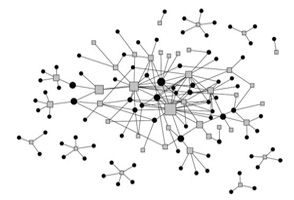December 8, 2011
DCDC Publication (in press)
Network Determinants of Knowledge Utilization: Preliminary Lessons From a Boundary Organization
By Beatrice I. Crona (1,2) and John N. Parker (3,4)
http://scx.sagepub.com/content/early/2011/09/08/1075547011408116
Abstract
This study examines the socio-organizational model of science-policy knowledge transfer. Using social network analysis, the authors study how interactions between researchers-policy makers affect utilization of research by policy makers in a boundary organization designed to mediate between research and policy communities. Two types of social interactions with independent effects on utilization are identified. Policy makers with more direct contacts with researchers are more likely to utilize research. Policy makers interacting more with other policy makers regarding research are also more likely to utilize it. This indicates the importance of policy makers’ embeddedness in social networks and the importance of external reputation of boundary organizations for successful knowledge transfer.
Case Study and Research Context

DCDC operates in the highly politicized context surrounding water management and urban development in the arid Southwestern United States. The Phoenix metropolitan area is one of the fastest growing urban centers in the United States, and tensions between urban development, economic growth, and environmental sustainability arise continuously (Gober, 2006; Gober, Kirkwood, Balling, Ellis, & Deitrick, 2010). Against this complex backdrop, DCDC was created in 2004 to support research from a diverse range of disciplines, including both the social and natural sciences, and to facilitate its transfer to the policy sphere. To date, the research has consisted primarily of social vulnerability assessments, climatic and hydrological models, science-policy research, and the development of new drought indices.
In its capacity as a boundary organization, DCDC engages over 150 researchers and policy actors but only employs around a dozen support and administrative staff. It meets all of the criteria definitive of a boundary organization. Most characteristically, it involves participation by both scientists and policy makers. DCDC leaders have accomplished this in three main ways.
- First, DCDC leaders developed a regular forum ("water and climate briefings") where researchers and policy makers meet to discuss research and its implications for water policy. The forum was designed to provide a depoliticized space that would facilitate interaction among these groups. When surveyed, policy makers indicated that these meetings were the main way in which the organization had influenced the water policy community, with over 60% indicating that their network of contacts in the water policy community had grown as a result (Crona & Parker, 2009).
- Second, they hold semiregular panels of expert speakers involving members of both communities; and third, they hired a professional liaison to act as a mediator between researchers and policy makers. DCDC has also created a number of boundary objects, the most important of which is WaterSim, a regional-scale simulation model of water supply and demand that integrates climate, land use, and population growth data to examine future water use scenarios (see White et al., 2010).
- Finally, DCDC has distinct lines of accountability to both the research and policy communities. Accountability to the research community is via its formal ties to the university and the National Science Foundation, and accountability to the policy community is by virtue of the inclusion of policy makers on its advisory board.
1 Arizona State University, Tempe, AZ, USA
2 Stockholm University, Stockholm, Sweden
3 National Center for Ecological Analysis and Synthesis, Santa Barbara, CA, USA
4 Barrett Honors College, Arizona State University

